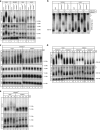The non-canonical poly(A) polymerase FAM46C acts as an onco-suppressor in multiple myeloma
- PMID: 28931820
- PMCID: PMC5606997
- DOI: 10.1038/s41467-017-00578-5
The non-canonical poly(A) polymerase FAM46C acts as an onco-suppressor in multiple myeloma
Abstract
FAM46C is one of the most frequently mutated genes in multiple myeloma. Here, using a combination of in vitro and in vivo approaches, we demonstrate that FAM46C encodes an active non-canonical poly(A) polymerase which enhances mRNA stability and gene expression. Reintroduction of active FAM46C into multiple myeloma cell lines, but not its catalytically-inactive mutant, leads to broad polyadenylation and stabilization of mRNAs strongly enriched with those encoding endoplasmic reticulum-targeted proteins and induces cell death. Moreover, silencing of FAM46C in multiple myeloma cells expressing WT protein enhance cell proliferation. Finally, using a FAM46C-FLAG knock-in mouse strain, we show that the FAM46C protein is strongly induced during activation of primary splenocytes and that B lymphocytes isolated from newly generated FAM46C KO mice proliferate faster than those isolated from their WT littermates. Concluding, our data clearly indicate that FAM46C works as an onco-suppressor, with the specificity for B-lymphocyte lineage from which multiple myeloma originates. FAM46C is one of the most frequently mutated genes in multiple myeloma (MM), but its molecular function remains unknown. Here the authors show that FAM46C is a poly(A) polymerase and that loss of function of FAM46C drives multiple myeloma through the destabilisation of ER response transcripts.
Conflict of interest statement
The authors declare no competing financial interests.
Figures









Similar articles
-
FAM46C controls antibody production by the polyadenylation of immunoglobulin mRNAs and inhibits cell migration in multiple myeloma.J Cell Mol Med. 2020 Apr;24(7):4171-4182. doi: 10.1111/jcmm.15078. Epub 2020 Mar 6. J Cell Mol Med. 2020. PMID: 32141701 Free PMC article.
-
Loss of FAM46C Promotes Cell Survival in Myeloma.Cancer Res. 2017 Aug 15;77(16):4317-4327. doi: 10.1158/0008-5472.CAN-16-3011. Epub 2017 Jun 15. Cancer Res. 2017. PMID: 28619709 Free PMC article.
-
The Interaction of the Tumor Suppressor FAM46C with p62 and FNDC3 Proteins Integrates Protein and Secretory Homeostasis.Cell Rep. 2020 Sep 22;32(12):108162. doi: 10.1016/j.celrep.2020.108162. Cell Rep. 2020. PMID: 32966780
-
The Immunity-malignancy equilibrium in multiple myeloma: lessons from oncogenic events in plasma cells.FEBS J. 2022 Aug;289(15):4383-4397. doi: 10.1111/febs.16068. Epub 2021 Jun 23. FEBS J. 2022. PMID: 34117720 Review.
-
Dissecting the Puzzling Roles of FAM46C: A Multifaceted Pan-Cancer Tumour Suppressor with Increasing Clinical Relevance.Cancers (Basel). 2024 Apr 27;16(9):1706. doi: 10.3390/cancers16091706. Cancers (Basel). 2024. PMID: 38730656 Free PMC article. Review.
Cited by
-
Genome Instability in Multiple Myeloma: Facts and Factors.Cancers (Basel). 2021 Nov 26;13(23):5949. doi: 10.3390/cancers13235949. Cancers (Basel). 2021. PMID: 34885058 Free PMC article. Review.
-
Comprehensive characterization of the mutational landscape in multiple myeloma cell lines reveals potential drivers and pathways associated with tumor progression and drug resistance.Theranostics. 2019 Jan 1;9(2):540-553. doi: 10.7150/thno.28374. eCollection 2019. Theranostics. 2019. PMID: 30809292 Free PMC article.
-
Cell of Origin and Genetic Alterations in the Pathogenesis of Multiple Myeloma.Front Immunol. 2019 May 21;10:1121. doi: 10.3389/fimmu.2019.01121. eCollection 2019. Front Immunol. 2019. PMID: 31231360 Free PMC article. Review.
-
NCTD elicits proapoptotic and antiglycolytic effects on colorectal cancer cells via modulation of Fam46c expression and inhibition of ERK1/2 signaling.Mol Med Rep. 2020 Aug;22(2):774-782. doi: 10.3892/mmr.2020.11151. Epub 2020 May 18. Mol Med Rep. 2020. Retraction in: Mol Med Rep. 2023 Oct;28(4):191. doi: 10.3892/mmr.2023.13078. PMID: 32468032 Free PMC article. Retracted.
-
Functions and mechanisms of RNA tailing by metazoan terminal nucleotidyltransferases.Wiley Interdiscip Rev RNA. 2021 Mar;12(2):e1622. doi: 10.1002/wrna.1622. Epub 2020 Jul 22. Wiley Interdiscip Rev RNA. 2021. PMID: 33145994 Free PMC article. Review.
References
Publication types
MeSH terms
Substances
Grants and funding
LinkOut - more resources
Full Text Sources
Other Literature Sources
Medical
Molecular Biology Databases
Research Materials

